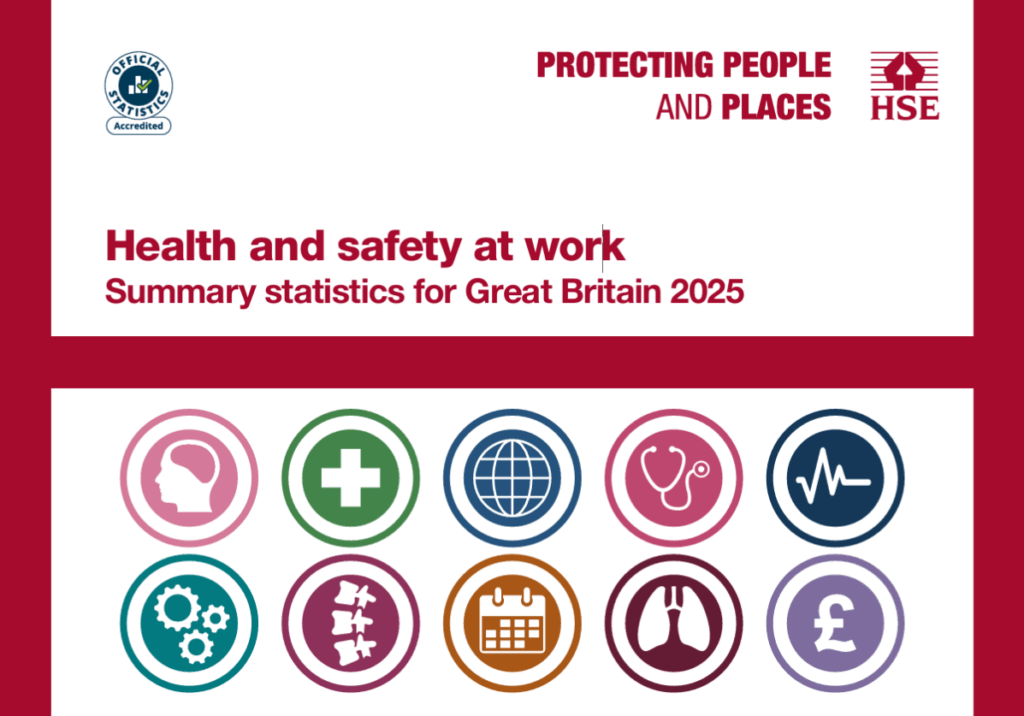The Health and Safety Executive (HSE)’s annual statistics on workplace health and safety in Great Britain have been released – here’s a summary of the key figures.
What are HSE’s annual health and safety statistics?
Every year, HSE, the UK government body responsible for workplace safety, produces a report on health and safety data from the previous 12 months.
The illuminating statistics highlight trends in work-related ill health and key areas of focus for employers.
The 2021/2022 statistics were released on 23 November 2022.
2021/2022 key workplace safety statistics
Here are some of the key stats from the latest report, released at the end of November.
- 1.8 million employees suffering from work-related illnesses
- 123 people killed in work-related accidents
- 565,000 workers sustained a non-fatal injury at work
- 36.8 million working days lost due to work-related illness and workplace injury
- 914,000 workers suffering work-related stress, depression or anxiety
- 123,000 workers suffering from COVID-19 believed to be from workplace exposure
Stress, depression and anxiety are the leading types of work-related illness
The statistics suggest that stress, depression and anxiety are the predominant forms of work-related illness in Britain. 914,000 workers – just over half of the 1.8 million total suffering from work-related ill health – are estimated to have stress, depression or anxiety as a result of their work.
Of the 914,000, 372,000 workers are suffering from a new case of work-related stress, depression or anxiety in 2021/22.
An estimated 17 million working days were lost in the 12 months assessed due to these mental health issues – more than half of all working days lost due to work-related ill health.
These statistics highlight a growing crisis in work-related stress and mental health problems.
Work-related musculoskeletal disorders
Musculoskeletal disorders make up the second-largest portion of work-related ill health, with 477,000 workers suffering from these in 2021/2022. Of these, 139,000 workers are suffering from a new disorder that began within the 12-month period.
An estimated 7.3 million working days were lost due to work-related musculoskeletal disorders in 2021/22.
Injuries sustained at work in 2021/22
There were 565,000 workers who sustained a non-fatal injury at work in 2021/22. Tragically, there were 123 workers killed in work-related accidents in the 12-month period too.
An estimated six million working days were lost due to non-fatal workplace injuries.
The impact of Covid-19 on workplace health
123,000 workers suffering from Covid-19 in 2021/22 believe they were exposed to the virus at work. Roughly 40 per cent of these workers are in the human health and social work sectors.
Ill health from workplace exposure
There are an estimated 13,000 deaths each year linked to past exposure at work, primarily to chemicals, dust or asbestos. Of these, 12,000 deaths are due to occupational lung disease.
An additional 585,000 workers are suffering from a work-related illness caused or made worse by the effects of the coronavirus pandemic, both new and long-standing.
The cost of workplace-related ill-health
Work-related injury and new cases of ill health cost Britain an estimated £18.8 billion in 2019/20. Of this, £7.6 billion was due to workplace injury and £11.2 billion was due to work-related ill health, excluding long latency illnesses such as cancer.
Top three industries with workplace injury in 2021/2022
- Agriculture, forestry and fishing
- Construction
- Accommodation/food service activities
Top three industries with work-related ill health in 2021/2022
- Human health/social work
- Public administration/defence
- Education
HSE: mental health in the workplace is a key priority
HSE’s Chief Executive, Sarah Albon, said: “Stress and poor mental health is the number one cause of work-related ill health. The effects of stress, depression, and anxiety can have a significant impact on an employee’s life and on their ability to perform their best at work.
“Britain is one of the safest places in the world to work but we need all employers to do more and take seriously their responsibilities to support good mental health at work. That’s why improving mental health in the workplace is a key priority in our ten-year strategy, ‘Protecting People and Places’, and why we’re developing new partnerships across industry to help employers support their employees.”
Investing in the safety and well-being of employees should be a priority for every organisation. At HCS Safety, our qualified team of health and safety advisers are here to make it easier for you.
We offer a large range of training courses, consultancy services and a membership service to help you keep your workers safe and well. To find out more and discuss your requirements, contact our team today.




